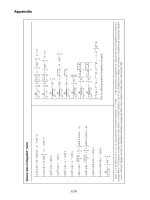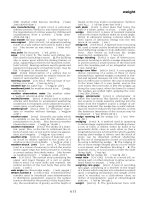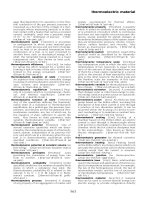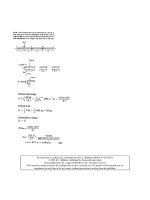Engineering Mechanics - Statics Episode 3 Part 7 pptx
Bạn đang xem bản rút gọn của tài liệu. Xem và tải ngay bản đầy đủ của tài liệu tại đây (440.52 KB, 40 trang )
Engineering Mechanics - Statics Chapter 10
Solution:
Moment and Product of Inertia about x and y Axes: Since the
shaded area is symmetrical about the x axis,
I
xy
0in
4
=
I
x
1
12
2ac
3
1
12
b 2a()
3
+= I
x
10.75 in
4
=
I
y
1
12
2ab
3
2ab a
b
2
+
⎛
⎜
⎝
⎞
⎟
⎠
2
+
1
12
c 2a()
3
+= I
y
30.75 in
4
=
Moment of Inertia about the Inclined u and v Axes
I
u
I
x
I
y
+
2
⎛
⎜
⎝
⎞
⎟
⎠
I
x
I
y
−
2
⎛
⎜
⎝
⎞
⎟
⎠
cos 2
θ
()
+ I
xy
sin 2
θ
()
−= I
u
15.75 in
4
=
I
v
I
x
I
y
+
2
⎛
⎜
⎝
⎞
⎟
⎠
I
x
I
y
−
2
⎛
⎜
⎝
⎞
⎟
⎠
cos 2
θ
()
− I
xy
sin 2
θ
()
+= I
v
25.75 in
4
=
Problem 10-78
Determine the directions of the principal axes with origin
located at point O, and the principal moments of inertia for
the rectangular area about these axes.
Given:
a 6in=
b 3in=
Solution:
I
x
1
3
ba
3
= I
x
216in
4
=
I
y
1
3
ab
3
= I
y
54in
4
=
I
xy
a
2
b
2
ab= I
xy
81in
4
=
1041
© 2007 R. C. Hibbeler. Published by Pearson Education, Inc., Upper Saddle River, NJ. All rights reserved.
This material is protected under all copyright laws as they currently exist. No portion of this material may
be reproduced, in any form or by any means, without permission in writing from the publisher.
Engineering Mechanics - Statics Chapter 10
tan 2
θ
()
2− I
xy
I
x
I
y
−
=
θ
1
2
atan 2
I
xy
I
x
− I
y
+
⎛
⎜
⎝
⎞
⎟
⎠
=
θ
22.5− deg=
I
max
I
x
I
y
+
2
I
x
I
y
−
2
⎛
⎜
⎝
⎞
⎟
⎠
2
I
xy
2
++= I
max
250in
4
=
I
min
I
x
I
y
+
2
I
x
I
y
−
2
⎛
⎜
⎝
⎞
⎟
⎠
2
I
xy
2
+−= I
min
20.4 in
4
=
Problem 10-79
Determine the moments of inertia I
u
, I
v
and the product of inertia I
uv
for the beam's cross-sectional
area.
Given:
θ
45 deg=
a 8in=
b 2in=
c 2in=
d 16 in=
Solution:
I
x
2
3
ab+()c
3
1
12
2bd
3
+ 2bd
d
2
⎛
⎜
⎝
⎞
⎟
⎠
2
+= I
x
5.515 10
3
× in
4
=
I
y
1
12
2 ab+()[]
3
c
1
12
2b()
3
d+= I
y
1.419 10
3
× in
4
=
I
xy
0in
4
=
I
u
I
x
I
y
+
2
I
x
I
y
−
2
cos 2
θ
()
+ I
xy
sin 2
θ
()
−= I
u
3.47 10
3
× in
4
=
I
v
I
x
I
y
+
2
I
x
I
y
−
2
cos 2
θ
()
− I
xy
sin 2
θ
()
+= I
v
3.47 10
3
× in
4
=
1042
© 2007 R. C. Hibbeler. Published by Pearson Education, Inc., Upper Saddle River, NJ. All rights reserved.
This material is protected under all copyright laws as they currently exist. No portion of this material may
be reproduced, in any form or by any means, without permission in writing from the publisher.
Engineering Mechanics - Statics Chapter 10
I
uv
I
x
I
y
−
2
sin 2
θ
()
I
xy
cos 2
θ
()
+= I
uv
2.05 10
3
× in
4
=
Problem 10-80
Determine the directions of the principal axes with
origin located at point O, and the principal moments
of inertia for the area about these axes.
Given:
a 4in=
b 2in=
c 2in=
d 2in=
r 1in=
Solution:
I
x
1
3
cd+()ab+()
3
π
r
4
4
π
r
2
a
2
+
⎛
⎜
⎝
⎞
⎟
⎠
−= I
x
236.95 in
4
=
I
y
1
3
ab+()cd+()
3
π
r
4
4
π
r
2
d
2
+
⎛
⎜
⎝
⎞
⎟
⎠
−= I
y
114.65 in
4
=
I
xy
ab+
2
⎛
⎜
⎝
⎞
⎟
⎠
dc+
2
⎛
⎜
⎝
⎞
⎟
⎠
ab+()dc+()da
π
r
2
−= I
xy
118.87 in
4
=
tan 2
θ
p
()
I
xy
−
I
x
I
y
−
2
=
θ
p
1
2
atan 2
I
xy
I
x
− I
y
+
⎛
⎜
⎝
⎞
⎟
⎠
=
θ
p
31.39− deg=
θ
p1
θ
p
=
θ
p1
31.39− deg=
θ
p2
90 deg
θ
p1
+=
θ
p2
58.61 deg=
I
max
I
x
I
y
+
2
I
x
I
y
−
2
⎛
⎜
⎝
⎞
⎟
⎠
2
I
xy
2
++= I
max
309in
4
=
1043
© 2007 R. C. Hibbeler. Published by Pearson Education, Inc., Upper Saddle River, NJ. All rights reserved.
This material is protected under all copyright laws as they currently exist. No portion of this material may
be reproduced, in any form or by any means, without permission in writing from the publisher.
Engineering Mechanics - Statics Chapter 10
I
min
I
x
I
y
+
2
I
x
I
y
−
2
⎛
⎜
⎝
⎞
⎟
⎠
2
I
xy
2
+−= I
min
42.1 in
4
=
Problem 10-81
Determine the principal moments of inertia for the
beam's cross-sectional area about the principal
axes that have their origin located at the centroid C.
Use the equations developed in Section 10.7. For
the calculation, assume all corners to be square.
Given:
a 4in= b 4in= t
3
8
in=
Solution:
I
x
2
1
12
at
3
at b
t
2
−
⎛
⎜
⎝
⎞
⎟
⎠
2
+
⎡
⎢
⎣
⎤
⎥
⎦
1
12
t 2b 2t−()
3
+=
I
x
55.55 in
4
=
I
y
2
1
12
ta t−()
3
ta t−()
at−
2
t
2
+
⎛
⎜
⎝
⎞
⎟
⎠
2
+
⎡
⎢
⎣
⎤
⎥
⎦
1
12
2bt
3
+= I
y
13.89 in
4
=
I
xy
2−
at−
2
t
2
⎛
⎜
⎝
⎞
⎟
⎠
+
⎡
⎢
⎣
⎤
⎥
⎦
b
t
2
−
⎛
⎜
⎝
⎞
⎟
⎠
ta t−()= I
xy
20.73− in
4
=
I
max
I
x
I
y
+
2
I
x
I
y
−
2
⎛
⎜
⎝
⎞
⎟
⎠
2
I
xy
2
++= I
max
64.1 in
4
=
I
min
I
x
I
y
+
2
I
x
I
y
−
2
⎛
⎜
⎝
⎞
⎟
⎠
2
I
xy
2
+−= I
min
5.33 in
4
=
1044
© 2007 R. C. Hibbeler. Published by Pearson Education, Inc., Upper Saddle River, NJ. All rights reserved.
This material is protected under all copyright laws as they currently exist. No portion of this material may
be reproduced, in any form or by any means, without permission in writing from the publisher.
Engineering Mechanics - Statics Chapter 10
Problem 10-82
Determine the principal moments of inertia for
the angle's cross-sectional area with respect to a
set of principal axes that have their origin located
at the centroid C. Use the equation developed in
Section 10.7. For the calculation, assume all
corners to be square.
Given:
a 100 mm=
b 100 mm=
t 20 mm=
Solution:
x
c
tb
t
2
at−()tt
at−
2
+
⎛
⎜
⎝
⎞
⎟
⎠
+
tb a t−()t+
= x
c
32.22 mm=
y
c
tb
b
2
at−()t
t
2
+
tb a t−()t+
= y
c
32.22 mm=
I
x
1
12
t
3
at−()ta t−()x
c
t
2
−
⎛
⎜
⎝
⎞
⎟
⎠
2
+
1
12
tb
3
+ tb
b
2
x
c
−
⎛
⎜
⎝
⎞
⎟
⎠
2
+= I
x
3.142 10
6
× mm
4
=
I
y
1
12
bt
3
bt x
c
t
2
−
⎛
⎜
⎝
⎞
⎟
⎠
2
+
1
12
ta t−()
3
+ ta t−()t
at−
2
+ x
c
−
⎛
⎜
⎝
⎞
⎟
⎠
2
+= I
y
3.142 10
6
× mm
4
=
I
xy
x
c
t
2
−
⎛
⎜
⎝
⎞
⎟
⎠
−
b
2
y
c
−
⎛
⎜
⎝
⎞
⎟
⎠
bt
at−
2
t+ x
c
−
⎛
⎜
⎝
⎞
⎟
⎠
y
c
t
2
−
⎛
⎜
⎝
⎞
⎟
⎠
at−()t−= I
xy
1.778− 10
6
× mm
4
=
I
max
I
x
I
y
+
2
I
x
I
y
−
2
−
⎛
⎜
⎝
⎞
⎟
⎠
I
xy
−= I
max
4.92 10
6
× mm
4
=
I
min
2.22 10
6
× mm
4
=
I
min
I
x
I
y
+
2
⎛
⎜
⎝
⎞
⎟
⎠
I
x
I
y
−
2
⎛
⎜
⎝
⎞
⎟
⎠
+ I
xy
+=
1045
© 2007 R. C. Hibbeler. Published by Pearson Education, Inc., Upper Saddle River, NJ. All rights reserved.
This material is protected under all copyright laws as they currently exist. No portion of this material may
be reproduced, in any form or by any means, without permission in writing from the publisher.
Engineering Mechanics - Statics Chapter 10
Problem 10-83
The area of the cross section of an airplane wing has the listed properties about the x and y axes
passing through the centroid C. Determine the orientation of the principal axes and the principal
moments of inertia.
Given:
I
x
450 in
4
= I
y
1730 in
4
= I
xy
138 in
4
=
Solution:
tan 2
θ
()
2− I
xy
I
x
I
y
−
=
θ
1
2
atan 2
I
xy
I
x
− I
y
+
⎛
⎜
⎝
⎞
⎟
⎠
=
θ
6.08 deg=
I
max
I
x
I
y
+
2
I
x
I
y
−
2
⎛
⎜
⎝
⎞
⎟
⎠
2
I
xy
2
++= I
max
1745in
4
=
I
min
I
x
I
y
+
2
I
x
I
y
−
2
⎛
⎜
⎝
⎞
⎟
⎠
2
I
xy
2
+−= I
min
435in
4
=
Problem 10-84
Using Mohr’s circle, determine the principal moments of inertia for the triangular area and the
orientation of the principal axes of inertia having an origin at point O.
Given:
a 30 mm=
b 40 mm=
1046
© 2007 R. C. Hibbeler. Published by Pearson Education, Inc., Upper Saddle River, NJ. All rights reserved.
This material is protected under all copyright laws as they currently exist. No portion of this material may
be reproduced, in any form or by any means, without permission in writing from the publisher.
Engineering Mechanics - Statics Chapter 10
Solution:
Moment of inertia I
x
and I
y
:
I
x
1
12
ba
3
= I
x
90 10
3
× mm
4
=
I
y
1
12
ab
3
= I
y
160 10
3
× mm
4
=
Product of inertia I
xy
:
I
xy
0
b
x
x
2
a
a
b
x−
⎛
⎜
⎝
⎞
⎟
⎠
2
⌠
⎮
⎮
⌡
d=
I
xy
60 10
3
× mm
4
=
Mohr's circle :
OA
I
x
I
y
+
2
I
x
−
⎛
⎜
⎝
⎞
⎟
⎠
2
I
xy
2
+=
OA 69.462 10
3
× mm
4
=
I
max
I
x
I
y
+
2
OA+
⎛
⎜
⎝
⎞
⎟
⎠
=
I
max
194.462 10
3
× mm
4
=
I
min
I
x
I
y
+
2
OA−
⎛
⎜
⎝
⎞
⎟
⎠
=
I
min
55.5 10
3
× mm
4
=
tan 2
θ
()
I
xy
I
x
I
y
+
2
I
x
−
=
θ
1
2
atan 2
I
xy
I
x
− I
y
+
⎛
⎜
⎝
⎞
⎟
⎠
=
θ
29.9 deg=
1047
© 2007 R. C. Hibbeler. Published by Pearson Education, Inc., Upper Saddle River, NJ. All rights reserved.
This material is protected under all copyright laws as they currently exist. No portion of this material may
be reproduced, in any form or by any means, without permission in writing from the publisher.
Engineering Mechanics - Statics Chapter 10
Problem 10-85
Determine the directions of the principal axes with origin
located at point O, and the principal moments of inertia
for the rectangular area about these axes.
Solve using Mohr's circle.
Given:
a 6in=
b 3in=
Solution:
I
x
1
3
ba
3
= I
x
216in
4
=
I
y
1
3
ab
3
= I
y
54in
4
=
I
xy
a
2
b
2
ab= I
xy
81in
4
=
RI
x
I
x
I
y
+
2
⎛
⎜
⎝
⎞
⎟
⎠
−
⎡
⎢
⎣
⎤
⎥
⎦
2
I
xy
2
+= R 114.55 in
4
=
I
max
I
x
I
y
+
2
R+= I
max
250in
4
=
I
min
I
x
I
y
+
2
R−= I
min
20.4 in
4
=
θ
p1
1−
2
asin
I
xy
R
⎛
⎜
⎝
⎞
⎟
⎠
=
θ
p1
22.50− deg=
θ
p2
θ
p1
90 deg+=
θ
p2
67.50 deg=
1048
© 2007 R. C. Hibbeler. Published by Pearson Education, Inc., Upper Saddle River, NJ. All rights reserved.
This material is protected under all copyright laws as they currently exist. No portion of this material may
be reproduced, in any form or by any means, without permission in writing from the publisher.
Engineering Mechanics - Statics Chapter 10
Problem 10-86
Determine the principal moments of inertia for the
beam's cross-sectional area about the principal
axes that have their origin located at the centroid
C. For the calculation, assume all corners to be
square. Solve using Mohr's circle.
Given:
a 4in=
b 4in=
t
3
8
in=
Solution:
I
x
2
1
12
at
3
at b
t
2
−
⎛
⎜
⎝
⎞
⎟
⎠
2
+
⎡
⎢
⎣
⎤
⎥
⎦
1
12
t 2b 2t−()
3
+= I
x
55.55 in
4
=
I
y
2
1
12
ta t−()
3
ta t−()
at−
2
t
2
+
⎛
⎜
⎝
⎞
⎟
⎠
2
+
⎡
⎢
⎣
⎤
⎥
⎦
1
12
2bt
3
+= I
y
13.89 in
4
=
I
xy
2−
at−
2
t
2
⎛
⎜
⎝
⎞
⎟
⎠
+
⎡
⎢
⎣
⎤
⎥
⎦
b
t
2
−
⎛
⎜
⎝
⎞
⎟
⎠
ta t−()= I
xy
20.73− in
4
=
RI
x
I
x
I
y
+
2
−
⎛
⎜
⎝
⎞
⎟
⎠
2
I
xy
2
+= R 29.39 in
4
=
I
max
I
x
I
y
+
2
R+= I
max
64.1 in
4
=
I
min
20.45 in
4
=
I
min
I
x
I
y
+
2
R−=
Problem 10-87
Determine the principal moments of inertia for the angle's cross-sectional area with respect to a set
of principal axes that have their origin located at the centroid C. For the calculation, assume all
corners to be square. Solve using Mohr's ciricle.
1049
© 2007 R. C. Hibbeler. Published by Pearson Education, Inc., Upper Saddle River, NJ. All rights reserved.
This material is protected under all copyright laws as they currently exist. No portion of this material may
be reproduced, in any form or by any means, without permission in writing from the publisher.
Engineering Mechanics - Statics Chapter 10
Given:
a 100 mm= b 100 mm= t 20 mm=
Solution:
x
c
tb
t
2
⎛
⎜
⎝
⎞
⎟
⎠
at−()tt
at−
2
+
⎛
⎜
⎝
⎞
⎟
⎠
+
tb a t−()t+
= x
c
32.22 mm=
y
c
tb
b
2
⎛
⎜
⎝
⎞
⎟
⎠
at−()t
t
2
⎛
⎜
⎝
⎞
⎟
⎠
+
tb a t−()t+
= y
c
32.22 mm=
I
x
1
12
t
3
at−()ta t−()x
c
t
2
−
⎛
⎜
⎝
⎞
⎟
⎠
2
+
1
12
tb
3
+ tb
b
2
x
c
−
⎛
⎜
⎝
⎞
⎟
⎠
2
+= I
x
3.142 10
6
× mm
4
=
I
y
1
12
bt
3
bt x
c
t
2
−
⎛
⎜
⎝
⎞
⎟
⎠
2
+
1
12
ta t−()
3
+ ta t−()t
at−
2
+ x
c
−
⎛
⎜
⎝
⎞
⎟
⎠
2
+=
I
y
3.142 10
6
× mm
4
=
I
xy
x
c
t
2
−
⎛
⎜
⎝
⎞
⎟
⎠
−
b
2
y
c
−
⎛
⎜
⎝
⎞
⎟
⎠
bt
at−
2
t+ x
c
−
⎛
⎜
⎝
⎞
⎟
⎠
y
c
t
2
−
⎛
⎜
⎝
⎞
⎟
⎠
at−()t−= I
xy
1.778− 10
6
× mm
4
=
RI
x
I
x
I
y
+
2
−
⎛
⎜
⎝
⎞
⎟
⎠
2
I
xy
2
+= R 1.78 10
6
× mm
4
=
1050
© 2007 R. C. Hibbeler. Published by Pearson Education, Inc., Upper Saddle River, NJ. All rights reserved.
This material is protected under all copyright laws as they currently exist. No portion of this material may
be reproduced, in any form or by any means, without permission in writing from the publisher.
Engineering Mechanics - Statics Chapter 10
I
max
I
x
I
y
+
2
R+= I
max
4.92 10
6
× mm
4
=
I
min
I
x
I
y
+
2
R−= I
min
1364444.44 mm
4
=
Problem 10-88
Determine the directions of the principal axes with
origin located at point O, and the principal moments
of inertia for the area about these axes. Solve using
Mohr's circle
Given:
a 4in=
b 2in=
c 2in=
d 2in=
r 1in=
Solution:
I
x
1
3
cd+()ab+()
3
π
r
4
4
π
r
2
a
2
+
⎛
⎜
⎝
⎞
⎟
⎠
−= I
x
236.95 in
4
=
I
y
1
3
ab+()cd+()
3
π
r
4
4
π
r
2
d
2
+
⎛
⎜
⎝
⎞
⎟
⎠
−= I
y
114.65 in
4
=
I
xy
ab+
2
⎛
⎜
⎝
⎞
⎟
⎠
dc+
2
⎛
⎜
⎝
⎞
⎟
⎠
ab+()dc+()da
π
r
2
−= I
xy
118.87 in
4
=
RI
x
I
x
I
y
+
2
⎛
⎜
⎝
⎞
⎟
⎠
−
⎡
⎢
⎣
⎤
⎥
⎦
2
I
xy
2
+= R 133.67 in
4
=
I
max
I
x
I
y
+
2
R+= I
max
309in
4
=
I
min
I
x
I
y
+
2
R−= I
min
42.1 in
4
=
1051
© 2007 R. C. Hibbeler. Published by Pearson Education, Inc., Upper Saddle River, NJ. All rights reserved.
This material is protected under all copyright laws as they currently exist. No portion of this material may
be reproduced, in any form or by any means, without permission in writing from the publisher.
Engineering Mechanics - Statics Chapter 10
θ
p1
1−
2
asin
I
xy
R
⎛
⎜
⎝
⎞
⎟
⎠
=
θ
p1
31.39− deg=
θ
p2
θ
p1
π
2
+=
θ
p2
58.61 deg=
Problem 10-89
The area of the cross section of an airplane wing has the listed properties about the x and y axes
passing through the centroid C. Determine the orientation of the principal axes and the principal
moments of inertia. Solve using Mohr's circle.
Given:
I
x
450 in
4
=
I
y
1730 in
4
=
I
xy
138 in
4
=
Solution:
RI
x
I
x
I
y
+
2
⎛
⎜
⎝
⎞
⎟
⎠
−
⎡
⎢
⎣
⎤
⎥
⎦
2
I
xy
2
+= R 654.71 in
4
=
I
max
I
x
I
y
+
2
R+
⎛
⎜
⎝
⎞
⎟
⎠
= I
max
1.74 10
3
× in
4
=
I
min
I
x
I
y
+
2
R−
⎛
⎜
⎝
⎞
⎟
⎠
= I
min
435in
4
=
1052
© 2007 R. C. Hibbeler. Published by Pearson Education, Inc., Upper Saddle River, NJ. All rights reserved.
This material is protected under all copyright laws as they currently exist. No portion of this material may
be reproduced, in any form or by any means, without permission in writing from the publisher.
Engineering Mechanics - Statics Chapter 10
θ
p1
1
2
asin
I
xy
R
⎛
⎜
⎝
⎞
⎟
⎠
=
θ
p1
6.08 deg=
θ
p2
θ
p1
90 deg+=
θ
p2
96.08 deg=
Problem 10-90
The right circular cone is formed by revolving the shaded area
around the x axis. Determine the moment of inertia l
x
and
express the result in terms of the total mass m of the cone. The
cone has a constant density
ρ
.
Solution:
m
0
h
x
ρπ
rx
h
⎛
⎜
⎝
⎞
⎟
⎠
2
⌠
⎮
⎮
⌡
d=
1
3
h
ρπ
r
2
=
l
x
3m
π
hr
2
0
h
x
1
2
π
rx
h
⎛
⎜
⎝
⎞
⎟
⎠
4
⌠
⎮
⎮
⌡
d=
3
10
mr
2
=
l
x
3
10
mr
2
=
Problem 10-91
Determine the moment of inertia of the thin ring about the z axis. The ring has a mass m.
1053
© 2007 R. C. Hibbeler. Published by Pearson Education, Inc., Upper Saddle River, NJ. All rights reserved.
This material is protected under all copyright laws as they currently exist. No portion of this material may
be reproduced, in any form or by any means, without permission in writing from the publisher.
Engineering Mechanics - Statics Chapter 10
Solution:
m
ρ
2
π
R=
ρ
m
2
π
R
=
I
0
2
π
θ
m
2
π
R
⎛
⎜
⎝
⎞
⎟
⎠
R
2
R
⌠
⎮
⎮
⌡
d= mR
2
= ImR
2
=
Problem 10-92
The solid is formed by revolving the shaded area
around the y axis. Determine the radius of gyration
k
y
. The specific weight of the material is
γ
.
Given:
a 3in=
b 3in=
γ
380
lb
ft
3
=
Solution:
m
0
b
y
γπ
a
y
b
⎛
⎜
⎝
⎞
⎟
⎠
3
⎡
⎢
⎣
⎤
⎥
⎦
2
⌠
⎮
⎮
⎮
⌡
d=
m 2.66lb=
I
y
0
b
y
γπ
a
y
b
⎛
⎜
⎝
⎞
⎟
⎠
3
⎡
⎢
⎣
⎤
⎥
⎦
2
1
2
a
y
b
⎛
⎜
⎝
⎞
⎟
⎠
3
⎡
⎢
⎣
⎤
⎥
⎦
2
⌠
⎮
⎮
⎮
⌡
d=
I
y
6.46 lb in
2
⋅=
k
y
I
y
m
= k
y
1.56 in=
1054
© 2007 R. C. Hibbeler. Published by Pearson Education, Inc., Upper Saddle River, NJ. All rights reserved.
This material is protected under all copyright laws as they currently exist. No portion of this material may
be reproduced, in any form or by any means, without permission in writing from the publisher.
Engineering Mechanics - Statics Chapter 10
Problem 10-93
Determine the moment of inertia I
x
for the sphere and express the result in terms of
the total mass m of the sphere. The sphere has a constant density
ρ
.
Solution:
m
ρ
4
π
r
3
3
=
ρ
3m
4
π
r
3
=
I
x
r−
r
x
1
2
3m
4
π
r
3
⎛
⎜
⎝
⎞
⎟
⎠
π
r
2
x
2
−
()
r
2
x
2
−
()
⌠
⎮
⎮
⌡
d=
2
5
mr
2
= I
x
2
5
mr
2
=
Problem 10-94
Determine the radius of gyration k
x
of the paraboloid. The density of the material is
ρ
.
Units Used:
Mg 1000 kg=
Given:
ρ
5
Mg
m
3
= a 200 mm= b 100 mm=
1055
© 2007 R. C. Hibbeler. Published by Pearson Education, Inc., Upper Saddle River, NJ. All rights reserved.
This material is protected under all copyright laws as they currently exist. No portion of this material may
be reproduced, in any form or by any means, without permission in writing from the publisher.
Engineering Mechanics - Statics Chapter 10
Solution:
m
p
0
a
x
ρπ
b
2
x
a
⎛
⎜
⎝
⎞
⎟
⎠
⌠
⎮
⎮
⌡
d=
m
p
15.71 kg=
I
x
0
a
x
1
2
ρπ
b
2
x
a
⎛
⎜
⎝
⎞
⎟
⎠
b
2
x
a
⎛
⎜
⎝
⎞
⎟
⎠
⌠
⎮
⎮
⌡
d=
I
x
52.36 10
3−
× kg m
2
⋅=
k
x
I
x
m
p
= k
x
57.7 mm=
Problem 10-95
Determine the moment of inertia of the semi-ellipsoid with respect to the x axis and
express the result in terms of the mass m of the semiellipsoid. The material has a
constant density
ρ
.
Solution:
m
0
a
x
ρπ
b
2
1
x
2
a
2
−
⎛
⎜
⎜
⎝
⎞
⎟
⎟
⎠
⌠
⎮
⎮
⎮
⌡
d=
2
3
a
ρπ
b
2
=
ρ
3m
2
π
ab
2
=
I
x
0
a
x
1
2
3m
2
π
ab
2
⎛
⎜
⎝
⎞
⎟
⎠
π
b
2
1
x
2
a
2
−
⎛
⎜
⎜
⎝
⎞
⎟
⎟
⎠
b
2
1
x
2
a
2
−
⎛
⎜
⎜
⎝
⎞
⎟
⎟
⎠
⌠
⎮
⎮
⎮
⌡
d=
2
5
mb
2
= I
x
2
5
mb
2
=
1056
© 2007 R. C. Hibbeler. Published by Pearson Education, Inc., Upper Saddle River, NJ. All rights reserved.
This material is protected under all copyright laws as they currently exist. No portion of this material may
be reproduced, in any form or by any means, without permission in writing from the publisher.
Engineering Mechanics - Statics Chapter 10
Problem 10-96
Determine the radius of gyration k
x
of the body. The specific weight of the material is
γ
.
Given:
γ
380
lb
ft
3
=
a 8in=
b 2in=
Solution:
m
b
0
a
x
γπ
b
2
x
a
⎛
⎜
⎝
⎞
⎟
⎠
2
3
⌠
⎮
⎮
⎮
⎮
⌡
d= m
b
13.26 lb=
I
x
0
a
x
1
2
γπ
b
2
x
a
⎛
⎜
⎝
⎞
⎟
⎠
2
3
b
2
x
a
⎛
⎜
⎝
⎞
⎟
⎠
2
3
⌠
⎮
⎮
⎮
⎮
⌡
d= I
x
0.59 slug in
2
⋅=
k
x
I
x
m
b
= k
x
1.20 in=
Problem 10-97
Determine the moment of inertia for the ellipsoid with respect to the x axis and express the result in
terms of the mass m of the ellipsoid. The material has a constant density
ρ
.
1057
© 2007 R. C. Hibbeler. Published by Pearson Education, Inc., Upper Saddle River, NJ. All rights reserved.
This material is protected under all copyright laws as they currently exist. No portion of this material may
be reproduced, in any form or by any means, without permission in writing from the publisher.
Engineering Mechanics - Statics Chapter 10
Solution:
m
a−
a
x
ρπ
b
2
1
x
2
a
2
−
⎛
⎜
⎜
⎝
⎞
⎟
⎟
⎠
⌠
⎮
⎮
⎮
⌡
d=
4
3
a
ρπ
b
2
=
ρ
3m
4
π
ab
2
=
I
x
a−
a
x
1
2
3m
4
π
ab
2
π
b
2
1
x
2
a
2
−
⎛
⎜
⎜
⎝
⎞
⎟
⎟
⎠
b
2
1
x
2
a
2
−
⎛
⎜
⎜
⎝
⎞
⎟
⎟
⎠
⌠
⎮
⎮
⎮
⌡
d=
2
5
mb
2
= I
x
2
5
mb
2
=
Problem 10-98
Determine the moment of inertia of
the homogeneous pyramid of mass m
with respect to the z axis. The density
of the material is
ρ
.
Suggestion: Use a
rectangular plate element having a
volume of dV = (2x)(2y) dz.
Solution:
V
0
h
za 1
z
h
−
⎛
⎜
⎝
⎞
⎟
⎠
⎡
⎢
⎣
⎤
⎥
⎦
2
⌠
⎮
⎮
⌡
d=
1
3
ha
2
=
ρ
m
V
=
3m
a
2
h
=
I
z
3m
a
2
h
0
h
z
1
6
a 1
z
h
−
⎛
⎜
⎝
⎞
⎟
⎠
⎡
⎢
⎣
⎤
⎥
⎦
4
⌠
⎮
⎮
⌡
d=
1
10
ma
2
= I
z
1
10
ma
2
=
1058
© 2007 R. C. Hibbeler. Published by Pearson Education, Inc., Upper Saddle River, NJ. All rights reserved.
This material is protected under all copyright laws as they currently exist. No portion of this material may
be reproduced, in any form or by any means, without permission in writing from the publisher.
Engineering Mechanics - Statics Chapter 10
Problem 10-99
The concrete shape is formed by rotating the shaded area about the y axis. Determine the moment of
inertia I
y
. The specific weight of concrete is
γ
.
Given:
γ
150
lb
ft
3
=
a 6in=
b 4in=
c 8in=
Solution:
I
y
1
2
γπ
ab+()
2
ca b+()
2
0
c
y
1
2
γπ
a
2
y
c
⎛
⎜
⎝
⎞
⎟
⎠
a
2
y
c
⌠
⎮
⎮
⌡
d−=
I
y
2.25 slug ft
2
⋅=
Problem 10-100
Determine the moment of inertia of the thin plate about an axis perpendicular to the page and passing
through the pin at O. The plate has a hole in its center. Its thickness is c, and the material has a
density of
ρ
Given:
a 1.40 m= c 50 mm=
b 150 mm=
ρ
50
kg
m
3
=
Solution:
I
G
1
12
ρ
a
2
ca
2
a
2
+
()
1
2
ρπ
b
2
cb
2
−=
I
G
1.60 kg m
2
⋅=
I
0
I
G
md
2
+=
1059
© 2007 R. C. Hibbeler. Published by Pearson Education, Inc., Upper Saddle River, NJ. All rights reserved.
This material is protected under all copyright laws as they currently exist. No portion of this material may
be reproduced, in any form or by any means, without permission in writing from the publisher.
Engineering Mechanics - Statics Chapter 10
m
ρ
a
2
c
ρπ
b
2
c−=
m 4.7233 kg=
I
0
I
G
masin 45 deg()()
2
+=
I
0
6.23 kg m
2
⋅=
Problem 10-101
Determine the moment of inertia I
z
of the frustum of the cone which has a conical depression. The
material has a density
ρ
.
Given:
ρ
200
kg
m
3
=
a 0.4 m=
b 0.2 m=
c 0.6 m=
d 0.8 m=
Solution:
h
da
ab−
=
I
z
3
10
ρ
1
3
π
a
2
h
⎛
⎜
⎝
⎞
⎟
⎠
⎡
⎢
⎣
⎤
⎥
⎦
a
2
3
10
ρ
1
3
π
a
2
c
⎛
⎜
⎝
⎞
⎟
⎠
⎡
⎢
⎣
⎤
⎥
⎦
a
2
−
3
10
ρ
1
3
π
b
2
hd−()
⎡
⎢
⎣
⎤
⎥
⎦
⎡
⎢
⎣
⎤
⎥
⎦
b
2
−=
I
z
1.53 kg m
2
⋅=
Problem 10-102
Determine the moment of inertia for the assembly about an axis which is perpendicular to the
page and passes through the center of mass G. The material has a specific weight
γ
.
Given:
a 0.5 ft= d 0.25 ft=
1060
© 2007 R. C. Hibbeler. Published by Pearson Education, Inc., Upper Saddle River, NJ. All rights reserved.
This material is protected under all copyright laws as they currently exist. No portion of this material may
be reproduced, in any form or by any means, without permission in writing from the publisher.
Engineering Mechanics - Statics Chapter 10
b 2ft= e 1ft=
c 1ft=
γ
90
lb
ft
3
=
Solution:
I
G
1
2
γπ
ab+()
2
ea b+()
2
1
2
γπ
b
2
ed−()b
2
−
1
2
γπ
c
2
dc
2
−=
I
G
118slug ft
2
⋅=
Problem 10-103
Determine the moment of inertia for the assembly about an axis which is perpendicular to the page and
passes through point O. The material has a specific weight
γ
.
Given:
a 0.5 ft= d 0.25 ft=
b 2ft= e 1ft=
c 1ft=
γ
90
lb
ft
3
=
Solution:
I
G
1
2
γπ
ab+()
2
ea b+()
2
1
2
γπ
b
2
ed−()b
2
−
1
2
γπ
c
2
dc
2
−=
I
G
118slug ft
2
⋅=
M
γπ
ab+()
2
e
γπ
b
2
ed−()−
γπ
c
2
d−= M 848.23 lb=
I
O
I
G
Ma b+()
2
+= I
O
283slug ft
2
⋅=
1061
© 2007 R. C. Hibbeler. Published by Pearson Education, Inc., Upper Saddle River, NJ. All rights reserved.
This material is protected under all copyright laws as they currently exist. No portion of this material may
be reproduced, in any form or by any means, without permission in writing from the publisher.
Engineering Mechanics - Statics Chapter 10
Problem 10-104
The wheel consists of a thin ring having a mass M
1
and four spokes made from slender rods, each
having a mass M
2
. Determine the wheel’s moment of inertia about an axis perpendicular to the page
and passing through point A.
Given:
M
1
10 kg=
M
2
2kg=
a 500 mm=
Solution:
I
G
M
1
a
2
4
1
3
M
2
a
2
+=
I
A
I
G
M
1
4M
2
+
()
a
2
+=
I
A
7.67 kg m
2
⋅=
Problem 10-105
The slender rods have a weight density
γ
.
Determine the moment of inertia for the assembly
about an axis perpendicular to the page and passing through point A.
Given:
γ
3
lb
ft
=
a 1.5 ft=
b 1ft=
c 2ft=
Solution:
I
1
3
γ
bc+()bc+()
2
1
12
γ
2a 2a()
2
+
γ
2ac
2
+=
I 2.17 slug ft
2
⋅=
1062
© 2007 R. C. Hibbeler. Published by Pearson Education, Inc., Upper Saddle River, NJ. All rights reserved.
This material is protected under all copyright laws as they currently exist. No portion of this material may
be reproduced, in any form or by any means, without permission in writing from the publisher.
Engineering Mechanics - Statics Chapter 10
Problem 10-106
Each of the three rods has a mass m. Determine the
moment of inertia for the assembly about an axis which is
perpendicular to the page and passes through the center
point O.
Solution:
I
O
3
1
12
ma
2
m
asin 60 deg()
3
⎛
⎜
⎝
⎞
⎟
⎠
2
+
⎡
⎢
⎣
⎤
⎥
⎦
=
I
O
1
2
ma
2
=
Problem 10-107
The slender rods have weight density
γ
.
Determine the moment of inertia for the assembly
about an axis perpendicular to the page and passing through point A
Given:
γ
3
lb
ft
=
a 1.5 ft=
b 2ft=
Solution:
I
A
1
3
γ
bb
2
1
12
γ
2a 2a()
2
+
γ
2a()b
2
+= I
A
1.58 slug ft
2
⋅=
Problem 10-108
The pendulum consists of a plate having weight W
p
and a slender rod having weight W
r .
Determine the radius of gyration of the pendulum about an axis perpendicular to the page and
passing through point O.
1063
© 2007 R. C. Hibbeler. Published by Pearson Education, Inc., Upper Saddle River, NJ. All rights reserved.
This material is protected under all copyright laws as they currently exist. No portion of this material may
be reproduced, in any form or by any means, without permission in writing from the publisher.
Engineering Mechanics - Statics Chapter 10
Given:
W
p
12 lb= a 1ft=
W
r
4lb= b 1ft=
c 3ft=
d 2ft=
Solution:
I
0
1
12
W
r
cd+()
2
W
r
cd+
2
c−
⎛
⎜
⎝
⎞
⎟
⎠
2
+
1
12
W
p
a
2
b
2
+
()
+ W
p
c
b
2
+
⎛
⎜
⎝
⎞
⎟
⎠
2
+=
k
0
I
0
W
p
W
r
+
= k
0
3.15 ft=
Problem 10-109
Determine the moment of inertia for the overhung crank about the x axis. The material is steel
having density
ρ
.
Units Used:
Mg 1000 kg=
Given:
ρ
7.85
Mg
m
3
=
a 20 mm=
b 20 mm=
c 50 mm=
d 90 mm=
e 30 mm=
Solution:
m
ρπ
a
2
⎛
⎜
⎝
⎞
⎟
⎠
2
c= m 0.12 kg=
M
ρ
2dbe= M 0.85 kg=
1064
© 2007 R. C. Hibbeler. Published by Pearson Education, Inc., Upper Saddle River, NJ. All rights reserved.
This material is protected under all copyright laws as they currently exist. No portion of this material may
be reproduced, in any form or by any means, without permission in writing from the publisher.
Engineering Mechanics - Statics Chapter 10
I
x
2
1
2
m
a
2
⎛
⎜
⎝
⎞
⎟
⎠
2
md e−()
2
+
⎡
⎢
⎣
⎤
⎥
⎦
1
12
M 2d()
2
e
2
+
⎡
⎣
⎤
⎦
+=
I
x
3.25 10
3−
× kg m
2
⋅=
Problem 10-110
Determine the moment of inertia for the overhung crank about the x' axis. The material is steel
having density
ρ
.
Units used:
Mg 1000 kg=
Given:
ρ
7.85
Mg
m
3
=
a 20 mm=
b 20 mm=
c 50 mm=
d 90 mm=
e 30 mm=
Solution:
m
ρπ
a
2
⎛
⎜
⎝
⎞
⎟
⎠
2
c= m 0.12 kg=
M
ρ
2dbe= M 0.85 kg=
I
x
2
1
2
m
a
2
⎛
⎜
⎝
⎞
⎟
⎠
2
md e−()
2
+
⎡
⎢
⎣
⎤
⎥
⎦
1
12
M 2d()
2
e
2
+
⎡
⎣
⎤
⎦
+=
I
x'
I
x
M 2m+()de−()
2
+= I
x'
7.19 10
3−
× kg m
2
⋅=
1065
© 2007 R. C. Hibbeler. Published by Pearson Education, Inc., Upper Saddle River, NJ. All rights reserved.
This material is protected under all copyright laws as they currently exist. No portion of this material may
be reproduced, in any form or by any means, without permission in writing from the publisher.









